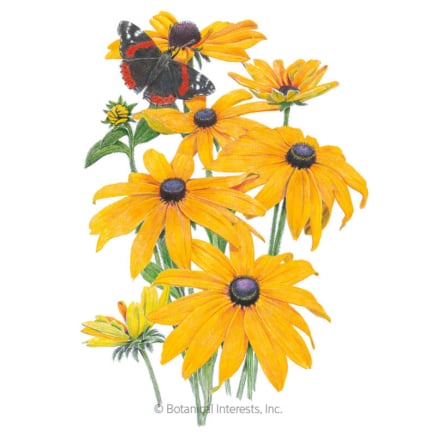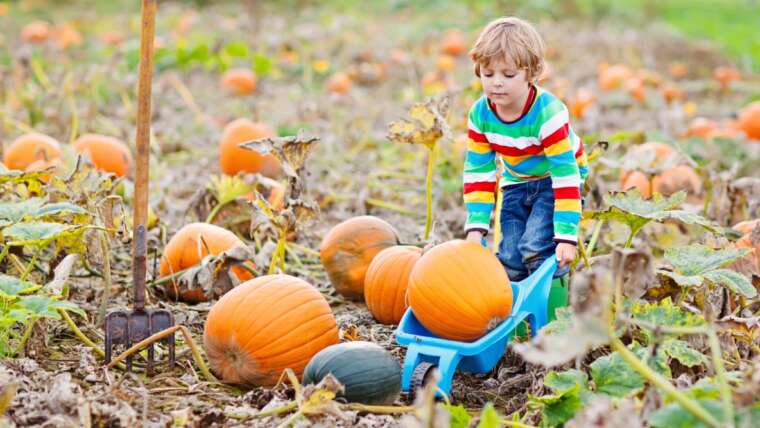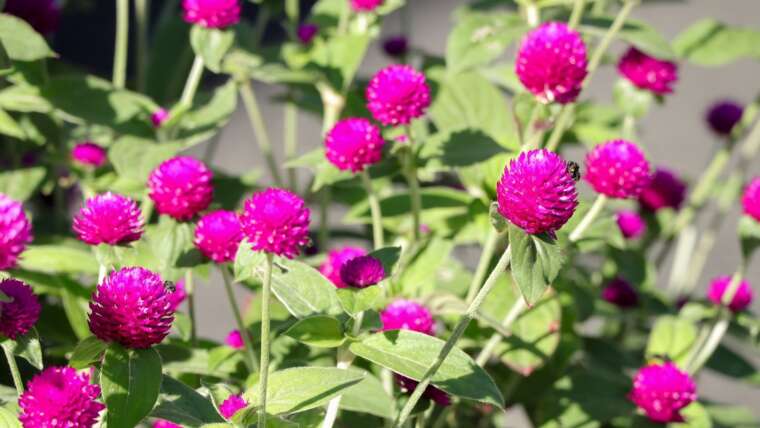Planting en masse, or in a grouping, is a simple landscape design technique that creates a big impact in the garden. Combining drifts and swaths of single-plant varieties brings high visual interest, movement, and texture to any garden style.
Planting in groups is one of the easiest ways to create unity in the landscape through repetition. Repeated plant sequences impact the visual appeal of space, help organize the overall experience, and lend a sense of balance. Repeating the same plant anchors the landscape, creating a backdrop for embellishments like showy plant specimens.
Mass planting streamlines the landscape while mimicking nature. Natural plant communities consist of a variety of plant types, often repeated. Massing is perfect for naturalistic styles but also for formal and informal garden settings alike. Flowering shrubs, evergreens, bulbs, exciting foliage plants, perennials, and annuals make ideal mass plantings.
Whether your garden is large or small, planting en masse brings impact and harmony to a space. It lets the plant shine with more heft than it might as a single planting. Combine groupings with plants of contrasting sizes, forms, or textures for added interest. When combining mass plant selections, opt for those with the same sun, moisture, and soil requirements. Ensure proper plant spacing to allow room for growth and infill.
Here are the best plants to grow en masse:
Black-eyed Susan
Zinnia

Echinacea

Paradiso Dwarf Blend Echinacea Seeds
Astilbe
 Combine astilbe with hosta and columbines for an impactful display.
Combine astilbe with hosta and columbines for an impactful display.
Astilbe brightens the shade garden with frothy, foamy, colorful plumes in summer. A long-lived perennial, astilbe is a garden favorite for its unique form and color in shade situations.
Astilbe features glossy green leaves with tinges of red and copper and dense, pyramidal bloom spikes. Feathery flowers rise above mounding leaves in shades of pinks, reds, purples, and whites.
Plant astilbe in groups for impact and pair with hosta, columbine, ferns, and heuchera. Seed heads develop post-bloom for lasting garden interest.
Astilbe is relatively easy to grow with consistent soil moisture and high organic matter. It suffers in dry periods. Plant it in light shade with dappled sun for best blooming.
Black-Eyed Susan
 This resilient perennial thrives in diverse environments.
This resilient perennial thrives in diverse environments.
A native wildflower, rudbeckia grows naturally in meadows and prairies and brings a variety of garden attributes. They bloom nonstop from summer through frost in a spectacular show of golden daisy-like flowers. Bright blooms with chocolate centers rise prolifically on single stems.
Black-eyed Susan is a long-blooming perennial native to parts of the South, Central, and Western United States. They’re adaptable plants that thrive in various conditions, including heat, humidity, and drought. Unfussy rudbeckia grows best in moist, well-drained soils without added fertilizers.
As easy care perennials, rudbeckia brightens the garden best when planted in a group and along borders. Rudbeckia self-seeds freely for successional blooms in seasons to come. They’re ideal for pollinator gardens and naturalized plantings among ornamental grasses and other flowering perennials.
Zinnia
 Enjoy edible zinnias as a garnish for summer salads or desserts.
Enjoy edible zinnias as a garnish for summer salads or desserts.
Zinnias bring dynamic color to the annual display with large, vibrant, double-disc flowers (also the perfect landing pads for pollinators). Zinnia blooms range in color from white to magenta to lime and bicolor. Plants grow low and mounding or tall and airy, depending on the variety.
Plant zinnias in a mass for a nonstop warm season display, with heat-loving blooms from early summer through frost. Cut flowers for arrangements— they’ll reward you with more blooms! Since zinnias are edible, enjoy them as a garnish for a summer salad, beverage, or dessert.
Zinnias need good air circulation, well-drained soil, and full sun to prevent pests and fungal diseases, especially in humid climates. In areas like the South with high heat and humidity, try disease-resistant varieties like the tall ‘Queeny Lime’ and ‘Profusion,’ a dwarf zinnia loaded with successional blooms.
Echinacea
 Purple coneflower is a classic native plant often found in gardens.
Purple coneflower is a classic native plant often found in gardens.
Echinacea— a favorite summer bloomer in vibrant hues of purples, pinks, reds, yellows, and oranges— brings recurring color to the perennial bed. Ray flowers surround a pronounced center of disc florets, a prime nectar source for beneficial insects. Dried seed heads bring lasting winter interest and provide food for wildlife.
Echinacea purpurea, or purple coneflower, is a quintessential garden native with purple petals surrounding an orange center. A natural prairie plant, coneflower thrives in summer heat and full sun. Well-draining soils are a must for best growth.
Coneflower grows in a variety of climates and reseeds naturally. Scatter seeds in fall and winter (or let them drop naturally) for spring germination. Mass plantings give waves of color all season long.
Azalea
 The large trumpet flowers of azaleas are attractive to hummingbirds and bees.
The large trumpet flowers of azaleas are attractive to hummingbirds and bees.
Azaleas make gorgeous specimens in woodland and naturalized gardens, especially in groups. From blush pink to vibrant scarlet, a profusion of spring, summer, and fall blooms bring color and fragrance to the garden.
Depending on the variety, azalea blooms range from white to shades of white, pink, purple, apricot, orange, and red. Large trumpet flowers attract hummingbirds, bees, and butterflies. While some species are low-growing, others grow upright with either a mounding or open, vase-shaped form. They are gorgeous sculptural elements in the understory of trees.
Azaleas make the biggest impact in groupings or mass plantings. The bold color show and foliage fill a space with multi-season interest. Follow light requirements per variety and provide rich, well-drained, evenly moist soils for best flowering and vigor.
Hydrangea
 Various hydrangea cultivars offer a wide range of colors and shapes.
Various hydrangea cultivars offer a wide range of colors and shapes.
Hydrangeas add a bounty of blooms to the landscape in an extensive planting. Their summer flowers overflow against a leafy backdrop, creating an unparalleled show with clusters of white, blue, and pink panicles or ball flower forms.
Like roses, hydrangeas pair beautifully with evergreens to anchor the arrangement, especially when leaves drop in the winter. They benefit from a border of low-growing boxwood or mixed perennials like hosta, heuchera, daffodils, and dianthus.
With so many cultivars available, there’s a hydrangea color and form for nearly every garden situation. Pick your favorite (maybe one that transitions from creamy white to fiery pink to blush, like H. paniculata ‘Firelight’) and enjoy the massive bloom show.
Roses
 Ensure there is sufficient airflow among rose plants to reduce the risk of fungal infections.
Ensure there is sufficient airflow among rose plants to reduce the risk of fungal infections.
Whether creating a carpet of ground cover blooms or a group of flowering shrubs, roses exude charm when planted en masse. Abundant color and fragrance fill the garden with drama and romance.
Rose gardens often incorporate anchoring evergreens like arborvitae or boxwood among mass plantings. Use specimen evergreens to define space and punctuate the looser rose forms. Plant groups of single rose varieties and mix and match groupings freely. Incorporate climbing roses to add vertical interest.
Grow roses in full sun (unless it’s a shade-tolerant variety) with rich, evenly moist soils with good drainage. Ensure proper spacing, with plenty of air circulation between plants, to reduce fungal diseases and pests.
Cosmos
 Excess water and organic matter can hinder cosmos’ growth.
Excess water and organic matter can hinder cosmos’ growth.
Sun-loving cosmos produce bundles of colorful ray blooms that float on tall, airy stems. This summer annual is native to the Americas and lends a wildflower look to the garden. Daisy-like flowers in vivid shades of yellow, apricot, bright pink, lavender, red, and chocolate (and many more) grow easily with little care.
Cosmos reseeds naturally and grows in hot, dry conditions with variable soils. When flowers go to seed, researchers recommend cutting plants back to 12 to 18 inches. Plants rebloom quickly. Let the cut stems fall in place so new seeds germinate for the next generation of blooms.
Grow cosmos quickly from seed in drier spots of the garden— more is always better for color and attracting pollinators. The delicate flowers make a more significant statement en masse. Intersperse cosmos with other sunny blooms like cleome, yarrow, and zinnia. Cosmos are no-fuss plants— too much water, fertilizer, and organic richness hinders plant vigor.
Butterfly Milkweed
 This plant exhibits striking red-orange bloom clusters that attract essential pollinators.
This plant exhibits striking red-orange bloom clusters that attract essential pollinators.
A garden bursting with milkweed creates a sustainable stopover for monarchs. Plant it in bunches— a load of blooms is more beneficial than dibs and dabs.
Butterfly milkweed (Asclepias tuberosa) boasts bright, flat-topped bloom clusters in red-orange. The vibrant blooms and sweet nectar attract those important pollinators and associated beneficial insects. Predatory insects like wasps, lacewings, and ladybugs help manage aphids that often accompany milkweed.
Asclepias incarnata, or swamp milkweed, is a prime choice for moist garden areas. Its natural habitat is along marshy pond edges, bogs, and woodlands. It produces lovely clusters of flat, deep pink blooms, making the perfect butterfly landing spot.
Look for region-specific native milkweed options from the Xerces Society for guidance on which milkweed is best for your garden. Avoid tropical milkweed (Asclepias curassavica), as it can actually harm native butterfly reproduction and migration patterns.
Hellebore
 These plants make a splendid sight when mass-planted beneath trees.
These plants make a splendid sight when mass-planted beneath trees.
Hellebores, or lenten roses, feature large, cupped-shaped nodding blooms atop dark green palmate leaves. These perennials bloom in late winter/early spring and grace the garden with evergreen or semi-evergreen leaves, depending on climate.
Hellebores’ toothed, palmate leaves provide interest year-round, and their exquisite single or double blooms bring beauty to the late winter landscape. Heavily hybridized for vigor and bloom density, hellebores feature a long bloom time in various colors, from creamy white to soft pink to wine red, with single or double flowers.
A gorgeous addition planted en masse under trees, as a border, or naturalized ground cover, hellebore pairs beautifully with other shade-loving plants like fern, heuchera, and hosta. Hellebores thrive naturally in moist, well-drained soils in a woodland setting. They colonize slowly in consistently moist, average soil and dappled light to full shade.
Daffodils
 Allow daffodil leaves to remain after flowering until they yellow and wither as temperatures increase.
Allow daffodil leaves to remain after flowering until they yellow and wither as temperatures increase.
Spring-flowering bulbs make gorgeous mass plantings, their abundant blooms sweeping the landscape. You can’t have too many flowering bulbs in drifts. Among the showiest spring bulbs, daffodils burst into the garden in late winter and early spring with trumpet blooms and cups of yellow, white, apricot, and pink.
Plant daffodil bulbs in the fall for a showy springtime display. Cluster bulbs of the same variety in groupings 3 to 6 inches apart and 4 to 6 inches deep. Scatter bulbs before covering them with soil and compost for a naturalized arrangement. Look to early, mid, and late-season bloomers for combinations of staggered seasonal flowers.
After blooming, let daffodil leaves persist until they turn yellow and die back as temperatures rise. Keeping the leaves lets bulbs continue photosynthesizing to absorb and store as much energy as possible for the next growing season.
Hosta
 Place hostas in partially shaded areas for optimal growth.
Place hostas in partially shaded areas for optimal growth.
Hostas bring lush, sculptural leaves to enrich the shade garden. They offer textural contrast and visual interest in leaf shapes from broad to strappy to curly. Dazzling tones of blue-green, emerald, and variegated foliage make hosta a versatile choice for massed shade plantings.
Hostas grace the garden in seemingly endless varieties, unmatched in exciting foliage. Let’s not forget the blooms that emerge in early summer in lavender or white. Tall bloom scapes float above the leafy base and attract hummingbirds.
Hostas prefers partial to full shade garden locations. Morning sun benefits bright or variegated varieties to retain color and vibrance. Provide well-draining soil and keep the soil consistently moist, especially early in the growing season.
Caladiums
 These fast-growing plants boast vibrant foliage that remains until frost.
These fast-growing plants boast vibrant foliage that remains until frost.
Caladiums enliven the annual display with distinct arrow-shaped leaves in decorative patterns and colors. Heights vary from low-growing to tall, in fancy and lance-leaved shapes. Fancy-leaved varieties are heart-shaped, with lance-leaved selections slightly strappier and elongated. Leaves are green, red, pink, or white— or combinations of each— with colorful veins, blotches, and splotches.
Easy to grow from small tubers, plant caladiums in a mass for the best display. When nighttime temperatures reach above 60°F (16°C), scatter bulbs in the garden bed and cover them with a few inches of soil. Water well until established and water regularly throughout the growing season. Caladiums are fast-growers with showy foliage that lasts until frost.
Caladiums thrive in partial shade or shade, with some varieties (especially red lance-leaved) suited to full sun. They’ll develop a spathe flower less showy than the foliage, so cut off the bloom to direct energy to the leaves.
Christmas Ferns
 Space Christmas ferns adequately to allow for mature growth and avoid overcrowding.
Space Christmas ferns adequately to allow for mature growth and avoid overcrowding.
Ferns add lushness to the understory garden with a soft, graceful, arching aesthetic. Fitting for cottage, woodland, and shade gardens, or among other native plantings, ferns make perfect mass plantings. Use single varieties in groups and combine them with other fern groupings for extra visual appeal.
Evergreen ferns, like Christmas ferns, bring multi-season interest when others are dormant. Companion plants for ferns include other shade-loving perennials like astilbe, heuchera, and tiarella. These enjoy the same cultural conditions of soil types and canopy cover and bring a splash of attractive foliage and flowers.
Plant ferns in the fall before frost or spring after the threat of final frost has passed. Follow recommended spacing guidelines to allow for mature growth while preventing overcrowding.
Daylilies
 These tough perennials boast tall flower stems emerging above strappy, bladed leaves.
These tough perennials boast tall flower stems emerging above strappy, bladed leaves.
Daylilies delight the garden with lovely flowers that open during the day and close at night. Each flower lasts only a day or two, but with abundant successional blooms, daylilies bring long-lasting color during the warm season. Mass planting ensures a big bloom show, whether a single variety or a combination of different daylilies.
Flower stems rise tall above mounds of strappy, bladed leaves in green or blue-green. As tough perennials, daylilies grow in a variety of soil conditions. They’ll do best in organic, evenly moist soils but adapt readily to lesser soils. Give daylilies full sun for best flowering.
Daylilies handle hot and cold climates and live for years with little care. For a tidy appearance, deadhead spent blooms and stems. Daylilies complement coreopsis, echinacea, geranium, sedum, and dark foliage plants like purple heart and Persian shield.
Final Thoughts:
Mass planting allows groups of plants to shine for high impact and interest. They create unity in the garden, convey garden style, and bring abundant seasonal appeal.
Achieve the look of mass planting even in small spaces with clustered groupings of single plant varieties in a garden bed or containers. Add a striking specimen plant to stand out as a focal point among the masses. The combinations are limitless— choose your garden theme, favorite colors, and arrangements, and go big with drifts of plant selections.




